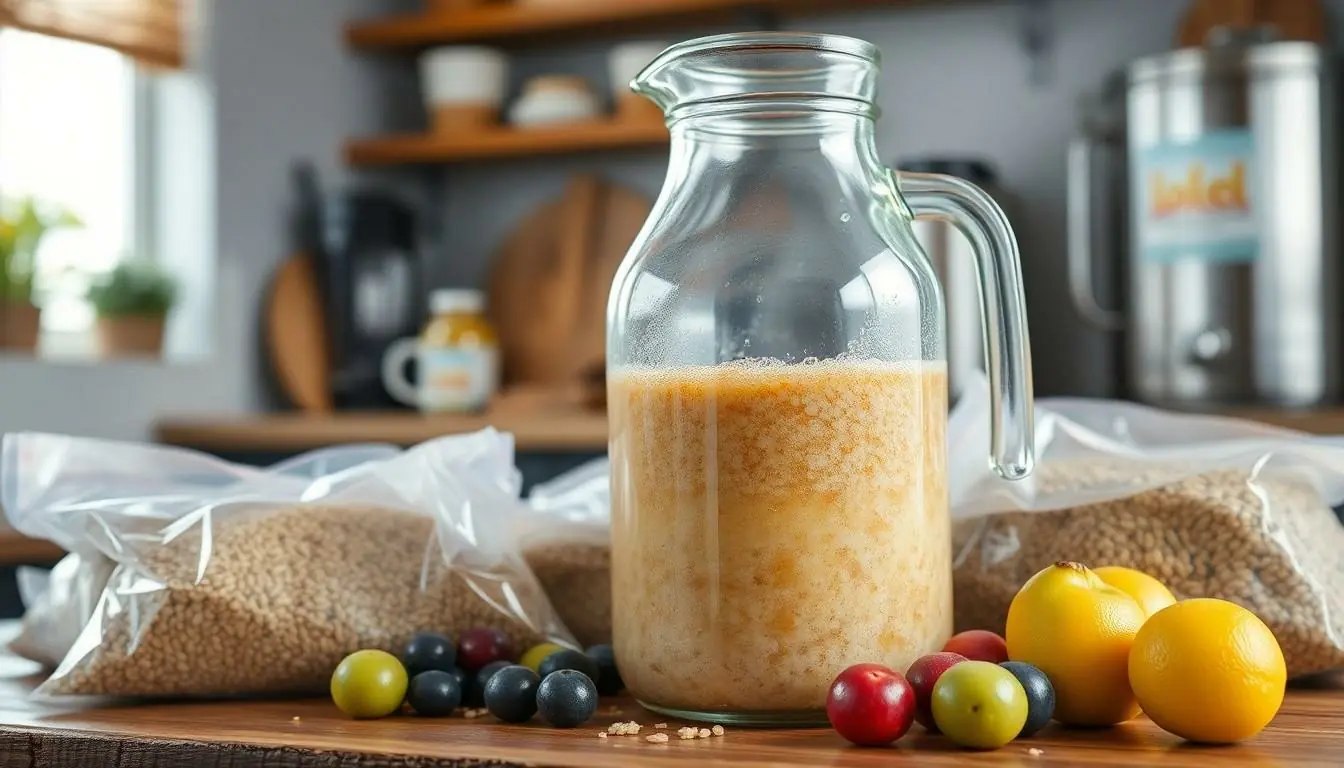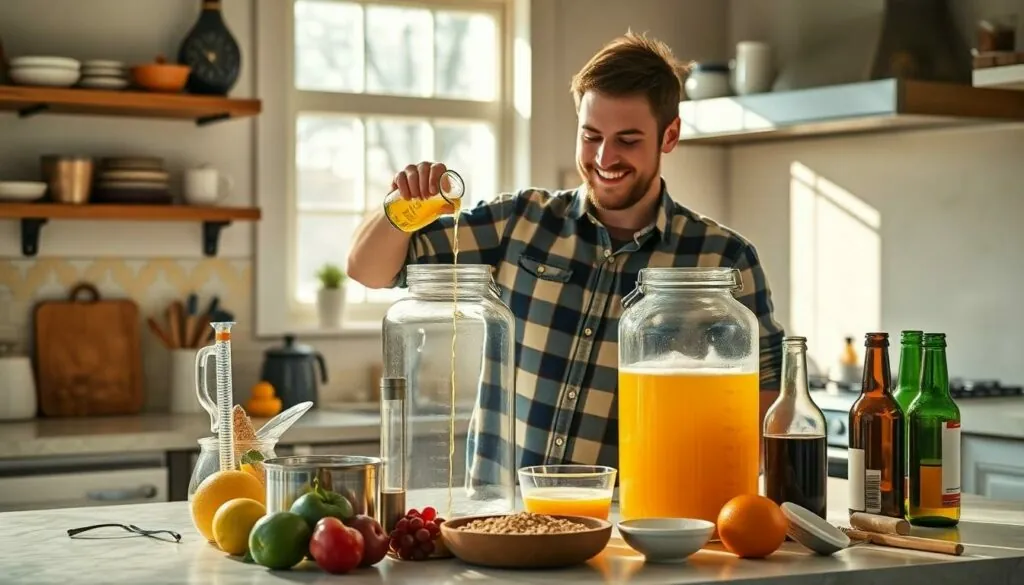Table of Contents
ToggleImagine this: a cozy evening, friends gathered around, laughter filling the air, and you’re the one serving up delicious homemade alcohol. Sounds like a scene from a feel-good movie, right? Well, it doesn’t have to be just a fantasy. With a little know-how, anyone can become a homebrewing wizard.
Understanding Alcohol Production
Alcohol production involves a few key processes that transform sugars into alcoholic beverages. Yeast plays a central role in fermentation, converting sugars from ingredients like grains, fruits, or sugarcane into ethanol and carbon dioxide. Sugars derive from the mashing of grains, the pressing of fruits, or the dilution of sugar in water.
Fermentation typically occurs in two stages. Primary fermentation lasts about one to two weeks. During this period, yeast consumes sugars, creating alcohol and releasing carbon dioxide. Secondary fermentation follows, which can last several weeks to months. This step clarifies the beer or wine by allowing sediments to settle and enhancing flavors.
Temperature control is essential throughout fermentation. Higher temperatures may lead to off-flavors, while cooler environments slow down fermentation. Most homebrewers aim for temperatures between 65°F and 75°F for optimal yeast activity.
Hygiene also plays a crucial role in alcohol production. Clean equipment prevents contamination, preserving the desired flavors. Using sanitizers on all brewing tools ensures that only the intended yeast influences the fermentation process.
After fermentation, the process continues with aging. Aging allows flavors to meld and develop complexity. This stage can take a few weeks for beers or several months for wines, depending on the desired outcome.
Bottling occurs after aging, requiring careful transfer to avoid disrupting sediments. Adding priming sugar during bottling can create carbon dioxide, resulting in carbonation in the finished product. With patience and attention to detail, homebrewers create enjoyable beverages that can rival commercially produced alcohol.
Essential Ingredients for Home Brewing

Home brewing alcohol requires specific ingredients to achieve the desired flavor and potency. Understanding these essentials lays the foundation for successful fermentation.
Water
Water serves as the primary ingredient in any brewing process. Quality matters, so using filtered or bottled water is preferred to avoid impurities. The mineral content in water impacts the final product, influencing taste and mouthfeel. Chlorinated water can inhibit yeast activity, which is critical for fermentation. Therefore, treating municipal water or sourcing pure spring water often leads to better results. Maintain temperature control, as water at room temperature around 68°F is ideal for mixing with ingredients.
Sugars
Sugars act as the fuel for yeast during fermentation. Various sources provide this necessary component, including malted grains, fruits, and cane sugar. Malted grains contribute not only sugars but also complex flavors. Fruits introduce unique profiles, adding acidity or sweetness depending on the type used. Cane sugar is a straightforward option, typically resulting in a cleaner taste. Concentration matters; home brewers usually target between 1.040 and 1.060 specific gravity for efficient fermentation. Adjusting sugar levels can alter alcohol content and sweetness.
Yeast
Yeast initiates the fermentation process, converting sugars into alcohol and carbon dioxide. Different yeast strains produce varying flavors and aromas. Ale yeasts ferment at warmer temperatures than lager yeasts, allowing for a broader range of styles. Selecting the right strain is essential; for example, a high-attenuating yeast will produce a drier beverage. Rehydration of dry yeast before adding it to the wort ensures active fermentation. Monitoring the fermentation temperature is crucial, as it influences the yeast’s effectiveness, typically ranging between 60°F and 75°F for most home brewing applications.
Equipment Needed for Home Brewing
Gathering the right equipment is crucial for successful home brewing. Essential tools and containers simplify the brewing process, making it more enjoyable.
Fermentation Vessels
Fermentation vessels are critical for creating alcohol. Glass carboys or plastic fermentation buckets work well, allowing for ample space for yeast activity. Choose a vessel that holds at least five gallons for standard homebrewing batches. Clear vessels provide visibility, while dark ones protect against light, preventing unwanted reactions. Ensure the selected fermenter has a tight-fitting lid to maintain an optimal environment and avoid contamination.
Airlocks and Bottles
Airlocks play a significant role in fermentation. These devices allow carbon dioxide to escape while preventing air from entering, minimizing spoilage risks. Utilizing a two-piece airlock is common for easy maintenance and monitoring. After fermentation, containers for bottling become necessary. Using glass bottles with caps enhances the preservation of flavors and carbonation. A bottle filler simplifies the bottling process, reducing spillage and ensuring clean fills. Maintaining sanitation throughout this phase is vital to guarantee high-quality alcohol.
Step-by-Step Guide to Making Alcohol at Home
Creating alcohol at home requires careful preparation and execution. Homebrewers can produce quality beverages by following these key steps.
Preparing the Ingredients
Quality ingredients form the backbone of successful brewing. Water plays a crucial role, with filtered or bottled options recommended for purity. Sugar sources can include malted grains, fruits, or cane sugar, which provide fuel for fermentation. Specific gravity measurement guides brewers in adjusting sugar levels for optimal fermentation efficiency. Choosing yeast strains adds variety, with different types yielding distinct flavors and aromas. Effective preparation ensures that all ingredients are measured accurately, promoting a smoother brewing process.
Fermentation Process
The fermentation phase transforms sugars into alcohol. Primary fermentation typically lasts one to two weeks, allowing yeast to convert sugars into ethanol and carbon dioxide. Maintaining optimal temperatures between 65°F and 75°F encourages yeast activity, enhancing flavor development. Monitoring the fermentation vessel for signs of bubbling signals active fermentation, providing peace of mind that the process is working. After completing primary fermentation, moving to secondary fermentation allows flavors to mature and complexities to develop.
Bottling and Aging
Bottling requires attention to detail and sanitation. Clean bottles with caps ensure a safe environment for the finished product. Adding priming sugar during bottling can create carbonation, adding a pleasant fizz to the beverage. After bottling, aging commences, allowing flavors to evolve over time. This process can take several weeks to months, with patience rewarding the brewer with a more refined drink. Properly stored bottles help maintain product quality, encouraging enjoyment during gatherings.
Safety Precautions When Brewing at Home
Prioritizing safety during home brewing is essential for both the quality of the alcohol and the well-being of the brewer. First, use sanitized equipment to prevent contamination. Clean containers and utensils help ensure that undesirable microorganisms do not spoil the brew.
Monitor your fermentation environment closely. Maintain consistent temperatures between 65°F and 75°F to optimize yeast activity. Fluctuations in temperature may lead to unwanted flavors and possibly spoilage.
Wear protective gear such as gloves and goggles when handling chemicals or cleaning agents. Some solutions can irritate the skin or eyes, so it’s wise to take precautions.
Be aware of your alcohol content. Accurate measurements of sugars during brewing can help predict the final alcohol percentage. Excessive alcohol levels can pose health risks.
Store finished products properly. Dark, cool places with minimized exposure to light prevent degradation of flavors and components within the beverage. Light can lead to oxidation and off-flavors.
Dispose of waste materials carefully. Yeast and trub can attract pests, so proper disposal methods are essential. Composting or sealing residual ingredients can mitigate unwanted encounters.
Remain mindful of local laws and regulations surrounding home brewing. Each region may have different guidelines regarding production limits and required permits, so research is necessary.
Lastly, trust in the brewing process. Patience during fermentation and aging enhances flavor complexity and overall enjoyment. Rushing the process can compromise the quality of the final product.
Homebrewing alcohol is a rewarding endeavor that combines creativity with science. By mastering the fermentation process and paying attention to detail, anyone can craft delicious beverages at home. The journey from selecting quality ingredients to the careful aging of the final product not only enhances one’s brewing skills but also creates memorable experiences during gatherings with friends.
With the right equipment and a commitment to safety, homebrewers can enjoy the fruits of their labor. Embracing patience and precision will lead to unique flavors that rival commercial options. As they explore this craft, aspiring brewers will find joy in each batch they create, turning simple ingredients into delightful drinks.







